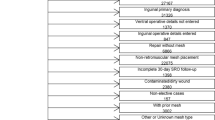Abstract
Background
The use of surgical drains after ventral hernia repair (VHR) remains controversial. Some have concerns of increased infectious complications; others advocate that drains reduce fluid accumulation and surgical site occurrences (SSO). The aim of our study was to investigate the impact of retromuscular drains on SSO following retromuscular VHR with synthetic mesh.
Methods
Utilizing the Americas Hernia Society Quality Collaborative, patients between January 2013 and January 2016 undergoing retromuscular VHR with synthetic mesh were assessed for the presence of a drain. Propensity score matched patients (2 drains: 1 no drain) were evaluated for 30-day rates of SSO, surgical site infections (SSI) and SSO requiring procedural intervention (SSOPI).
Results
Five hundred eighty-one patients were identified as having undergone open, retromuscular VHR with synthetic mesh. Four hundred eighty-one patients with drains and 100 without drains. After matching, 300 patients were compared, 200 with drain placement and 100 without. Retromuscular drains were less likely to develop a noninfectious SSO (OR, 0.33). Drain placement was not associated with SSI (OR, 1.30) or SSOPI (OR, 0.94).
Conclusion
Drain placement after retromuscular VHR with synthetic mesh is a common practice. Based on an analysis of early outcomes, surgical drains do not increase the risk of surgical infectious complications, and may be protective against some SSOs, such as seroma formation.
Similar content being viewed by others
References
Ramshaw B, Dean J, Forman B, Heidel E, Gamenthaler A, Fabian M. Can abdominal wall reconstruction be safely performed without drains? Am Surg. 2016;82(8):707–12
Karayacin K, Besim H, Ercan F, Hamamci O, Korkmaz A. Thyroidectomy with or without drains. East Afr Med J. 1997;74(7):431–2
Moro ML, Carrieri MP, Tozzi AE, Lana S, Greco D. Risk factors for surgical wound infections in clean surgery: a multicenter study. Italion PRINOS styduy group. Ann Ital Chir. 1996;67(1):13–9
Pessaux P, Msika S, Atalla D, Hay JM, Flamant Y. Risk factors for postoperative infectious complications in noncolorectal abdominal surgery: a multivariate analysis based on a prospective multicenter study of 4718 patients. Arch Surg. 2003;138(3):314–24
Tabaqchali MA, Hanson JM, Proud G. Drains for thyroidectomy/parathyroidectomy: fact or fiction? Ann R Coll Surg Engl. 1999;81(5):302–5
Tang R, Chen HH, Wang YL, Changchien CR, Chen JS, Hsu KC, Chiang JM, Wang JY. Risk factors for surgical site infection after elective resection of the colon and rectum: a single-center prospective study of 2,809 consecutive patients. Ann Surg. 2001;234(2):181–9
White TJ, Santos MC, Thompson JS. Factors affecting wound complicationsin repair of ventral hernias. Am Surg. 1998;64(3)276–80
Benedetti-Panici P, Maneschi F, Cutillo G, D’Andrea G, di Palumbo VS, Conte M, Scambia G, Mancuso S. A randomized study comparing retroperitoneal drainage with no drainage after lymphadenectomy in gynecologic malignancies. Gynecol Oncol. 1997;65(3):378–82
Hurtado-Lopez LM, Lopez-Romero S, Rizzo-Fuentes C, Zaldivar-Ramirez FR, Cervantes-Sanchez C. Selective use of drains in thyroid surgery. Head and Neck. 2001;23(3)189–93
Debry C, Renou G, Fingerhut A. Drainage after thyroid surgery: a prosscpective randomized study. J Laryngol Otol. 1999;113(1):49–51
Poulose BK, Roll S, Murphy JW, Mathews BD, Heniford T, Voeller G, Hope WW, Goldblatt MI, Adrales GL, Rosen MJ. Design and implementation of the Americas Hernia Society Quality Collaborative (AHSQC): improving value in hernia care. Hernia. 2016;20(2):177–189.
Poulose BK, Shelton J, Phillips S, Moore D, Nealon W, Penson D, Beck W, Holzman MD. Epidemiology and cost of ventral hernia repair: making the case for hernia research. Hernia. 2012;16(2):179–183.
Gurusamy KS, Allen VB. Wound drains after incisional hernia repair. Cochrane Database Syst Rev. 2013;17(12):CD005570
Shafik A. The electrified drain. A new device for sterilizing the field of drainage. Int Surg. 1993;78(4):357–9
Westphalen AP, Araujo AC, Zacharias P, Rodrigues ES, Frcaro GB, Lopes Filho Gde J. Repair of large incisional hernias. To drain or not to drain. Randomized clinical trial.Acta Cir Bras. 2015;30(12):844–51
Luijendijk RW, Hop WC, van den Tol MP, de Lange DC, Braaksma MM, IJzermans JN, Boelhouwer RU, de Vries BC, Salu MK, Wereldsma JC, Bruijninckx CM, Jeekel J. A comparison of suture repair with mesh repair for incisional hernia. N Engl J Med. 2000;343(6):392–8
Krpata DM, Blatnik JA, Novitsky YW, Rosen MJ. Posterior and open anterior compoents separations: a comparative analysis. Am J Surg. 2012;203(3):318–22
Plymale MA, Harris JW, Davenport DL, Smith N, Levy S, Scott Roth J. Abdominal wall reconstruction: The uncertainty of the impact of drain duration upon outcomes. Am Surg. 2016;82(3):207–11
Funding
All listed authors have contributed to the conception and designs of this study and/or acquisition, analysis, or interpretation of the data. All authors have drafted or revised the manuscript and approved the final version. All authors agree to be accountable for all aspects of this work.
Author information
Authors and Affiliations
Corresponding author
Rights and permissions
About this article
Cite this article
Krpata, D.M., Prabhu, A.S., Carbonell, A.M. et al. Drain Placement Does Not Increase Infectious Complications After Retromuscular Ventral Hernia Repair with Synthetic Mesh: an AHSQC Analysis. J Gastrointest Surg 21, 2083–2089 (2017). https://doi.org/10.1007/s11605-017-3601-0
Received:
Accepted:
Published:
Issue Date:
DOI: https://doi.org/10.1007/s11605-017-3601-0




